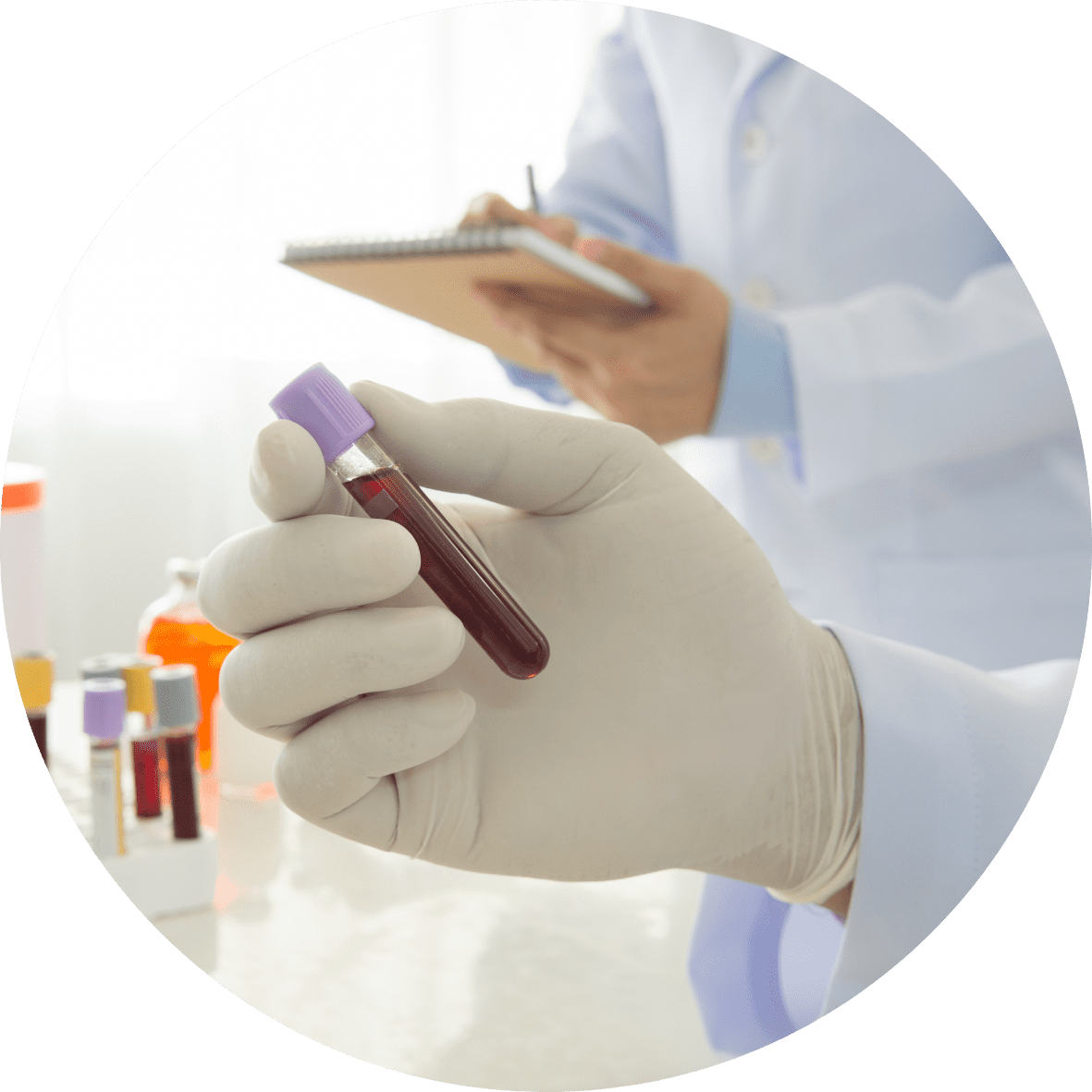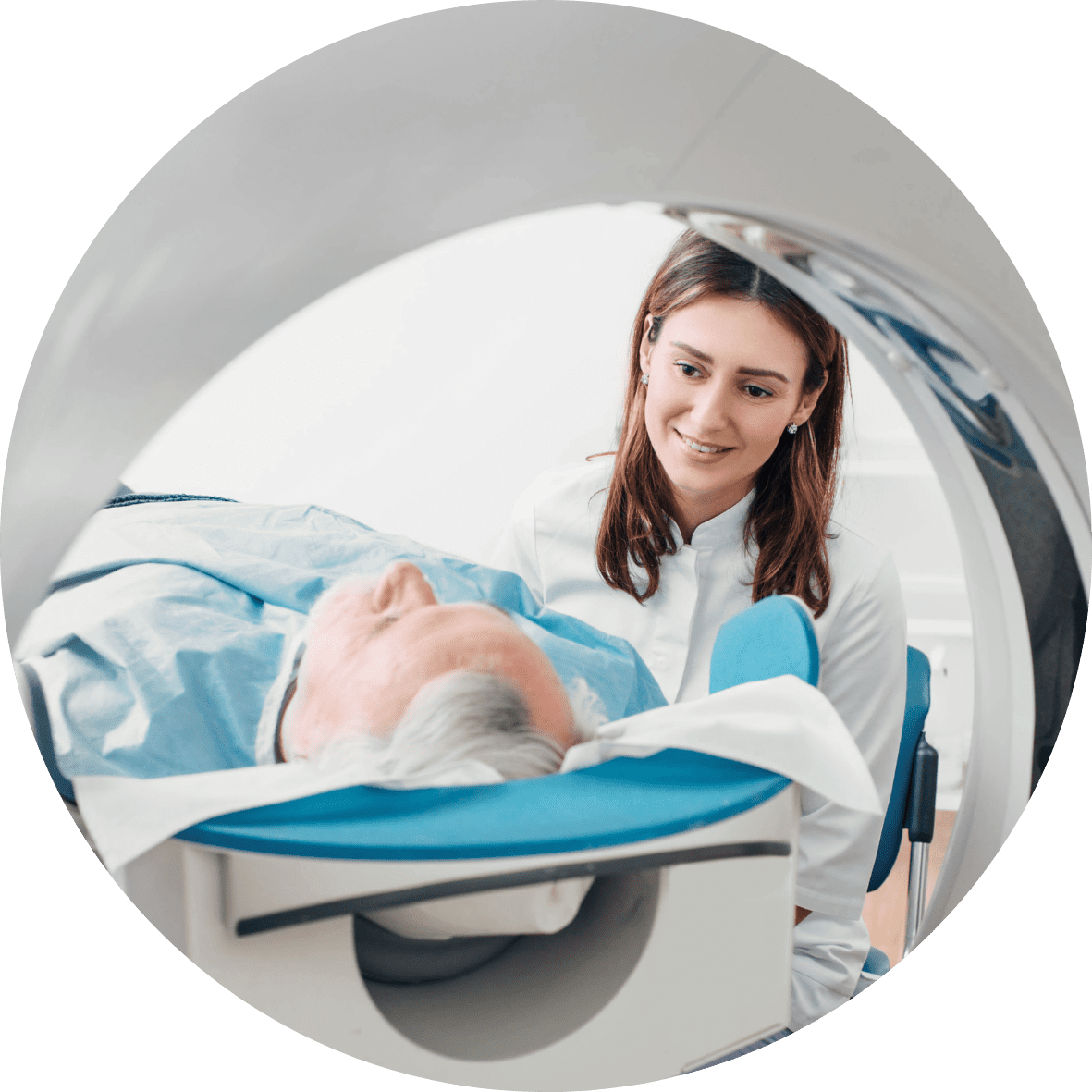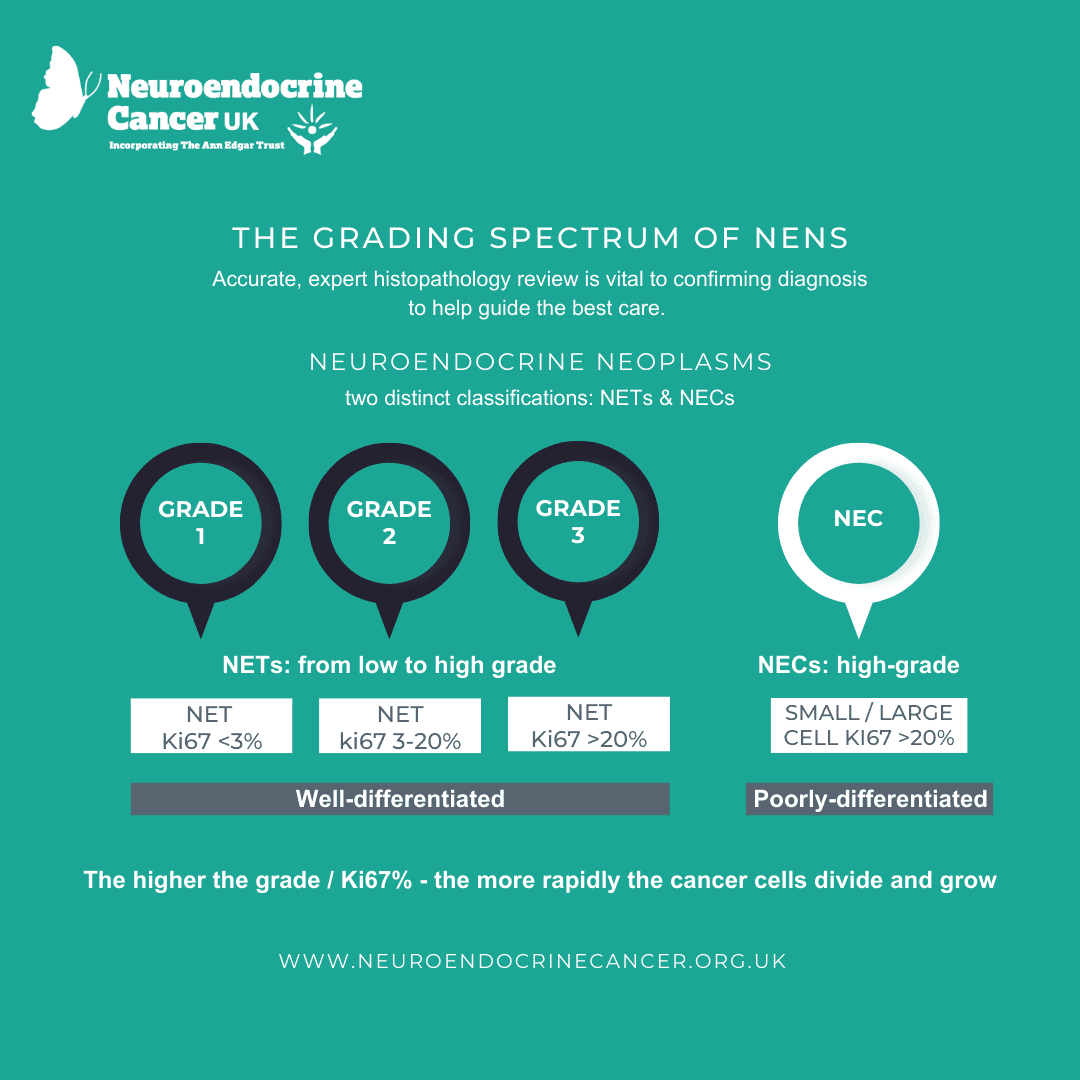Neuroendocrine Cancer of the Breast
Here, you’ll find resources tailored to those affected by neuroendocrine cancer of the breast. We offer comprehensive information on causes, symptoms, diagnosis, and treatment options. Dive into inspiring patient stories, stay updated on research developments, and access expert insights. Our community is here to support you, providing both emotional guidance and practical advice.
Explore treatment approaches, connect with others who understand your journey, and discover ways to lead a fulfilling life during and after treatment. You’re not alone in this – together, we’re here to educate and support.
Click to skip to:

The Facts
Neuroendocrine Neoplasm (NENs) serves as an umbrella term encompassing a cluster of cancers originating in neuroendocrine cells. These cancers might also be denoted as NETs, NECs, or Carcinoids. NENs manifest when neuroendocrine cells deviate from their normal function, undergoing abnormal growth or behaviour.
Two principal types of NEN exist:
1. NETs (neuroendocrine tumours): Characterised as ‘well-differentiated‘, these tumours usually exhibit a gradual to moderate growth pattern.
2. NECs (neuroendocrine carcinomas): Identified as ‘poorly differentiated‘, these tumours tend to grow rapidly.
To simplify matters, we employ the term NENs throughout this page.

Breast NENs
Primary Neuroendocrine Cancers of the breast (NECB) are rare, comprising less than 5% of all breast cancers. They are typically diagnosed during tests or following breast cancer surgery. In some cases, the breast can also serve as a secondary site, where Neuroendocrine Cancer has spread from elsewhere in the body.
Accurate and expert histopathology review is essential for confirming the diagnosis.
As of the World Health Organisation’s 2012 classification, NECB is categorised into three subtypes:
1. Well-differentiated neuroendocrine tumour (NET)
2. Poorly differentiated neuroendocrine carcinomas or small-cell carcinomas (NEC)
3. Invasive breast carcinomas with neuroendocrine differentiation, which differs from both NET and NEC.
While there are no current standardised treatment guidelines, there is a consensus that care should be personalised, and seeking specialist opinion is advisable.
Symptoms
Symptoms of neuroendocrine cancer of the breast may or may not include neuroendocrine cancer-associated syndromes, which are characterised by the occurrence of two or more related symptoms.
Neuroendocrine cancer of the breast is uncommon and is typically discovered during tests or treatments for suspected breast cancer or other conditions. Therefore, if symptoms do occur, they would resemble those associated with suspected breast cancer:
- A change in the size or shape of one or both breasts
- Discharge from either of your nipples, possibly streaked with blood
- A lump or swelling in either of your armpits
- Dimpling on the skin of your breasts
- A rash on or around your nipple
- A change in the appearance of your nipple, such as it becoming sunken into your breast
Breast pain is not a common symptom of breast cancer.
Neuroendocrine cancer of the breast is rarely associated with a neuroendocrine-associated syndrome. Additionally, other rarer symptoms, including paraneoplastic syndrome and oncological emergencies (specific health concerns that can occur in any cancer), such as raised calcium levels (hypercalcemia), may also occur.

Types of Tests
Tests that may be employed for the diagnosis and monitoring of Neuroendocrine Cancer of the Breast include:
Blood and/or Urine Tests:
- Full blood count
- Liver and kidney function
- Lipid profile
- Breast cancer genetics
- Chromogranin A
- Urinary or serum 5HiAA (serotonin)


Scans:
- Mammogram
- Breast and axilla (armpit) ultrasound scan
- CT or MRI breast
If further disease (spread) or a different primary site is suspected, additional tests may include:
- CT chest and abdomen and/or CT chest and MRI abdomen
- Bone scintigraphy (if bone metastases are suspected)
- Octreotide (SPECT) or Gallium-Dotatate PET/CT
Pathology (microscopic examination for cellular characteristics):
- Differentiation and cellular morphology
- Synaptophysin
- Chromogranin

Diagnosis and Grading
Receiving a diagnosis of breast neuroendocrine cancer can be an unexpected and challenging moment in your life. We understand the range of emotions and questions that may arise during this time, and we’re here to provide you with the support and information you need.
Breast neuroendocrine cancer is a complex condition with various subtypes and behaviours. Each diagnosis is unique, and understanding your situation is essential for making informed decisions about your care. It’s important to remember that not all cancers are the same – some may grow slowly, while others are more aggressive. This diversity underscores the significance of understanding your diagnosis and its implications.
Our ‘Just Diagnosed’ page is designed to be your go-to resource during this phase. We offer valuable information on what to expect, access to specialist care, and emotional support.
More than just information, our website also connects you with a supportive community. Sharing experiences with others who have faced similar challenges can be profoundly comforting and enlightening. We encourage you to explore our online community groups and support groups, where you can find understanding, advice, and a network of individuals ready to uplift you.
Remember, you’re not alone on this pathway. Together, we can navigate the intricacies of neuroendocrine cancer and work towards the best possible outcomes. Visit our ‘Just Diagnosed’ page to access vital resources and connect with a community that cares. Your well-being is our priority, and we’re here to stand by your side every step of the way.
Understanding Grading
Not all cancers share the same characteristics or exhibit uniform behaviour. Among them, there exist variations in growth speed, invasiveness of nearby structures, and propensity for spreading to other body parts upon diagnosis. While some cancers grow gradually and may not have infiltrated surrounding structures or disseminated, they still possess the potential to do so. On the other hand, certain cancers may have already spread by the time of diagnosis.
The grade of cancer indicates the rate of its growth. You might encounter terms such as ‘Ki67’ or ‘Mitotic Index’ in your clinic letters or medical reports indicating the grade. This classification ranges from Grade 1, representing a slow-growing nature, to Grade 3, signifying a more aggressive and rapidly progressing disease. Understanding the grade provides crucial insights into the behaviour and potential trajectory of the NEN.

How is Neuroendocrine cancer of the Breast Treated?
When it comes to planning treatments, there are many factors to consider, ensuring that your treatment plan is tailored to your specific needs and the type of NEN you’re dealing with. It’s important to recognise that your treatment and follow-up strategies could differ significantly even if you share a diagnosis with another patient. The uniqueness of your situation is taken into account for a personalised approach.
Your dedicated care team will discuss your treatment options comprehensively, providing written and verbal information to facilitate an informed decision-making process. Collaboratively, you and your team will choose the most suitable treatment plan. It’s widely recognised that all NEN patients should undergo a specialist Multidisciplinary Team (MDT) assessment.
The available treatment options depend on factors like the type, location, and size of your NEN and whether it has spread and how far. Your overall health, existing health issues, and fitness level are also considered.
When meeting with your medical professionals or specialist nurse/team, the primary objective is to ensure you have all the information necessary to comprehend your condition fully. This empowered understanding is a crucial foundation for your treatment journey.
Treatment
The primary goal of treatment is to ensure that you receive the best possible care and maintain the highest quality of life. This involves providing access to appropriate treatment, managing symptoms effectively, and addressing what matters most to you.
The choice of treatment options will depend on several factors, including the type, location, and size of your cancer, as well as whether and to where it has spread. It will also take into account any other health concerns, illnesses, and your overall health and fitness.
One or more of the following approaches may be recommended:
- Surgery
- Surveillance
- Chemotherapy
- Targeted Molecular Therapies
- Radiotherapy
- Peptide receptor radionuclide therapy (PRRT)
- Clinical Trials
- Symptom control
Surgery is employed to control your disease, with the goal of slowing or halting further growth and spread.
Surgery plays a vital role in the management of neuroendocrine cancer, involving various approaches:
- Breast-Conserving Surgery: Also known as a lumpectomy, quadrantectomy, partial, or segmental mastectomy, this procedure removes only the part of the breast containing the cancer along with some surrounding normal tissue. The extent of breast removal depends on the tumour’s location, size, and other factors.
- Mastectomy: This surgery entails the complete removal of the entire breast, including all breast tissue and, in some cases, adjacent tissues. For certain individuals, a double mastectomy may be necessary, involving the removal of both breasts.
Surgery may also serve the following purposes:
- To determine whether the cancer has spread to the lymph nodes under the arm, which can involve a sentinel lymph node biopsy or axillary lymph node dissection.
- To restore the breast’s shape after cancer removal, a process known as breast reconstruction.
- Relieve symptoms of advanced cancer.
Surveillance involves monitoring through clinic reviews, blood tests, and scans. It serves to assess the effectiveness of treatment or to check for any changes during periods between treatments, which may span months or years.
Since not everyone requires continuous treatment, surveillance plays a crucial role in keeping an eye on your cancer and overall health for any signs of change that might indicate the need for treatment. Recognising when treatment may be beneficial is essential, especially considering the potential side effects of treatments.
Chemotherapy can be administered in the form of oral tablets or intravenously (through a vein) to slow tumour growth or attempt to reduce tumour size. In high-grade disease, especially ‘poorly differentiated’ NEC, chemotherapy may be the primary therapy, sometimes used in combination with other treatments. Additionally, chemotherapy can enhance tumor cell sensitivity to radiation therapies.
Targeted Molecular Therapies can be administered orally (in tablet form) or intravenously (through a vein) to slow tumour growth or attempt to reduce tumour size.
Radiotherapy is occasionally administered to the breast, chest wall, or armpit area following surgery to eliminate any remaining cancer cells. It may also be employed for cancer that has extended beyond the breast, especially when it has spread to the bones. In such cases, radiotherapy is used to manage the growth of the spreading cancer and alleviate bone pain.
Peptide Receptor Radionuclide Therapy (PRRT), sometimes referred to as Radioligand Therapy, employs targeted radiation to treat neuroendocrine cancer cells. It may be recommended for some patients who have tested ‘positive’ on an Octreotide or Gallium scan, indicating ‘receptor positive’ disease.
Clinical research and the safe development of new treatments are essential to provide the best care for individuals with neuroendocrine cancer. It’s crucial to ensure that treatments not only work but are also safe. Clinical trials involve multiple phases, each with specific criteria for patient suitability. These criteria can be discussed with your clinical team. It’s important to note that participation in a trial is voluntary, and you have the choice to take part or not.
Symptom control, which is also known as ‘palliation,’ plays a crucial role in overall care. It is not limited to end-of-life care but occurs throughout the care process. Symptom control involves the use of various approaches to alleviate or reduce the impact that cancer, other health issues, and treatments may have on your physical and mental health. These approaches can range from simple medication to a combination of the treatments mentioned above, as well as counselling and practical support.
Follow-up and Management of Breast Neuroendocrine Cancer
Expert-agreed guidelines exist to determine when and how follow-up should take place, but in practice, variations occur, often for valid reasons. Follow-up should be informed by experts and based on evidence and research while also being tailored to your individual needs for the best care.
Following treatment for early breast cancer, the recommended follow-up includes:
- Annual breast screening for five years after treatment.
- Regular breast clinic reviews every three to four months for the first two years, followed by reviews every six months for years three – five.
- After five years, follow the NHS Breast Screening Programme timings, which may differ depending on your age.
– Women with early invasive breast cancer typically do not undergo tests for cancer elsewhere in the body unless they exhibit symptoms of possible disease spread.
– Women at high risk of breast cancer due to family history or genetic mutations may receive additional screening based on their age and level of risk.
Neuroendocrine cancer of the breast can potentially spread to multiple sites, even after routine follow-up is completed. Therefore, longer-term follow-up is recommended. Here’s the advice regarding follow-up for neuroendocrine cancer of the breast, taking into account grading and differentiation (NET or NEC):
- Grade 1-2 (Ki67 <20%) NET:
– R0 resection (complete removal, no lymph node or distant metastases): Contrast CT chest/abdo post-surgery, then follow the NHS Breast Screening Programme.
– R1 or evidence of lymph node +/- distant metastases: Longer-term follow-up is recommended, including annual CT scans. - G3 (Ki67 >20%) NET or NEC:
– R0 resection: Contrast CT chest/abdo three months post-surgery, then follow the National Breast Screening Programme.
– R1 or evidence of lymph node +/- distant metastases: Longer-term follow-up is recommended, including annual CT scans (every two – three months if on therapy).
– Biochemistry may serve as a surrogate marker in primary breast NEN.
– Biopsy is recommended in metachronous disease, especially after a long disease-free interval.
For advanced disease, follow-up should align with guidelines but should also be guided by prognosis, expected treatment efficacy, and treatment-related toxicity. The individual’s health, well-being, physical activity, informed choices, preferences for ongoing care, and treatment goals should be reviewed and discussed to plan the best care.
Secondary breast neuroendocrine cancer should be followed up according to the guidelines for the primary site.
Causes / Risk Factors
The exact causes of neuroendocrine cancer are still unknown. Nevertheless, it is crucial to heed advice on leading a healthy lifestyle, which includes maintaining a balanced diet, regular exercise, and avoiding smoking and excessive alcohol consumption.
While most neuroendocrine cancers are not hereditary, certain rare conditions can increase the risk of developing this type of cancer. Therefore, it’s essential to inform your specialist team not only about your personal medical history but also about any family medical illnesses or conditions.
In the case of breast cancer, it’s worth noting that it does not typically run in families. However, specific genes, such as BRCA1 and BRCA2, are associated with an increased risk of both breast and ovarian cancer. Genes like TP53 and CHEK2 are also linked to a higher risk of breast cancer.
If there is a family history of breast, ovarian, or neuroendocrine cancer, or if you have a known genetic alteration, we strongly recommend discussing this with your GP and specialist team. They may refer you for an NHS genetic test to determine if you have inherited one of the cancer-risk genes.
Neuroendocrine cancer of the breast is exceedingly rare and may not be associated with the genetic alterations mentioned above. However, in cases where there is a strong family history of breast, ovarian, or neuroendocrine cancer, or if you do have a genetic alteration, this information can help inform your care and ensure appropriate follow-up.

Further Support
For those seeking support, we offer resources such as support groups and online groups that provide a platform for patients and their families to connect, share experiences, and find comfort in a strong network.
Additionally, we encourage individuals to consider participating in clinical trials or research studies, as this contributes to the advancement of NEN understanding and treatment and empowers patients to engage in their healthcare journey actively.
Thank you for choosing us as your resource for breast neuroendocrine cancer information. We are dedicated to providing accurate, insightful, and supportive content as you navigate this pathway. If you have any further questions or concerns, please don’t hesitate to reach out.

